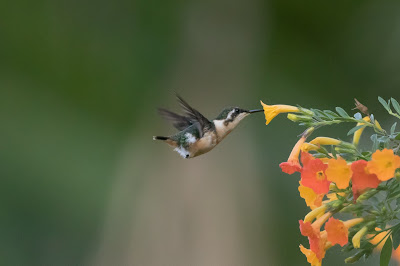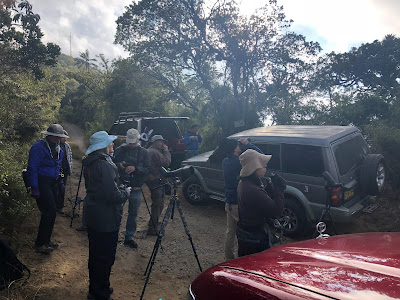I have to enjoy these subtle signs of spring. My schedule has me jumping from place to place and, although some people people probably see these tropical destinations and drool a little, I often look forward to being home to see the signs of the changing seasons.
Despite this rambling, I AM here to pass on a few pictures from the last tour I was on. I joined Richard Webster (on his second-to-last tour) in Colombia where we ran the Santa Marta Escape tour that he generated many years ago. In 2019, I'll be leading this 9-day tour and so it was great to return again this year to better learn the ropes. As always, you can find more info about this tour here on our webpage.
This tour starts and ends in the city of Barranquilla which is a short 2-3 hour flight from Miami. Our first morning out, we visited a scrubby area nearby to see the CHESTNUT-WINGED CHACHALACA, a Colombian endemic:
We moved up the road a bit to Isla Salamanca, a well-known birding locale with lots to offer. Each of the last two years I've been there, we've turned up a PIED PUFFBIRD:
The most common woodcreeper in this area is the STRAIGHT-BILLED WOODCREEPER with its distinctively pale, dagger-shaped bill:
Marshy areas nearby host a great number of SNAIL KITES including this one flying off with lunch:
We eventually end up in Camarones, an oceanside town where we enjoy a great number of shorebirds, herons, and terns as well as superb sunsets:
The next day we birded the dry and scrubby areas of the Guajira Peninsula. Although it's not a lush paradise that one might expect, the habitat in this part of the world is rather special. It's shared with neighboring Venezuela and, because not many birders are visiting that country right now, this part of Colombia is rich with potential for visiting birders. One of the more range restricted species we try for is the sneaky TOCUYO SPARROW. An improvement over last year, this time we actually SAW one. This picture was the best I could do with the secretive dude:
This dry country also hosts some stunners. You might recognize this as a cardinal... and you'd be right. This is the VERMILION CARDINAL which is only found in a sliver of Colombia and some in Venezuela:
Ok, so maybe this next one isn't as colorful... but it's still fascinating. It's a PILEATED FINCH, another specialty of the dry habitat:
The scrub around Camarones plays host to a variety of flycatchers that we snagged such as NORTHERN SCRUB-FLYCATCHER, SLENDER-BILLED TYRANNULET, MOUSE-COLORED TYRANNULET, and this PEARLY-VENTED TODY-TYRANT:
It's also wise to watch out for small green parrots too. This is the GREEN-RUMPED PARROTLET and it's another regional specialty:
Look carefully at the cargo:
Bike on bike.
Anyway, we eventually move uphill into the Sierra Nevada de Santa Marta, a main focus for this tour. As we started the climb, we birded around Minca where this GRAYISH SALTATOR was in full song:
The SWALLOW TANAGERS are beautiful, common, and always a fan favorite:
With a big bill for big insects, this STREAKED FLYCATCHER sat quietly allowing us to get great looks:
Higher yet, we reached the RNA El Dorado Lodge, our home for 4 nights. It sits at 6000' and has a completely different makeup of birds compared to the lowlands. It's on this climb up that we started to see species that are found no where else on earth. For example, we reached the elevation range of WHITE-LORED WARBLER, a species endemic to these mountains:
Although not endemic, this RUFOUS-AND-WHITE WREN popped out giving me the best looks I've had of this sneaky species:
We found a cooperative CINNAMON FLYCATCHER or two. Given what they look like, it's hardly a surprise that they were named that:
You might hear the high and piercing song of a GOLDEN-BREASTED FRUITEATER in these mountains as well. We tracked one down and were rewarded with stunning looks:
But honestly, once you reach the lodge, it's hard to pull yourself away from the feeders. This eco-lodge hosts a variety of stunning hummingbirds and, generally, this tour is good for hummingbird diversity. Here are a couple of shots from this tour, all without flash:
CROWNED WOODNYMPH:
WHITE-TAILED STARFRONTLET:
BLACK-THROATED MANGO:
SANTA MARTA WOODSTAR:
STEELY-VENTED HUMMINGBIRD:WHITE-NECKED JACOBIN:
BLACK-BACKED THORNBILL:
BROWN VIOLETEAR:
The lodge also puts out fruit for a variety of other species like this BLACK-CAPPED TANAGER:
... and this BLUE-NAPED CHLOROPHONIA:
Meanwhile, the cracked corn feeders attracted BLACK-CHESTED JAYS:
... and BAND-TAILED GUANS. Here's one that was content watching me watching it:
If you can actually pull yourself away from the feeders, you might walk the road to find more goodies. After all, MASKED TROGONS are fairly common in the forest around the lodge:
One of the prized targets for birders is the WHITE-TIPPED QUETZAL. Yes, there are quetzals on the lodge grounds! Here's one we found nearby:
Probably the main attraction though is making the 4x4 crawl up to the top of the Cuchilla de San Lorenzo. This ridge, sitting at 8400', is home to a host of endemic birds that aren't seen anywhere else. We ventured up twice and, when you have to leave at the early hour of 4:30 AM, we had time to look for some owls on the way up. We encountered the "SANTA MARTA" SCREECH-OWL (a species that doesn't even have a common name yet!) and this MOTTLED OWL:
At the top of the ridge, as the day breaks, we have a quick picnic breakfast while standing around our 4x4 vehicles:
... and then we get birding! The birds, just where we park, are often special. Here's a SANTA MARTA WARBLER near the vehicles:
This endemic is often found only at this one spot on tour, if at all. It has been missed before by some groups.This year the ridge was quite reliable for the endemic SANTA MARTA PARAKEETS:
With a population of only a couple of thousand, it was a treat to see and study these.
Also on the ridge was a cooperative SANTA MARTA BUSH-TYRANT, another tough species that can be missed:
Just down the road from the ridge is a station where they've taught a few SANTA MARTA ANTPITTAS to come in for food. We stopped by and, sure enough, they popped out of the thick undergrowth to wow us birders:
Our group really enjoyed an encounter with this CRIMSON-CRESTED WOODPECKER on the ridge as well. This female posed quite nicely!
When you're up on the ridge seeing lifers left and right, it's hard not to be happy! Here's our group, with a couple of our 4x4 drivers, smiling for a photo:
Last but not least, equal to the birds up on the ridge, is the view. With the tallest peaks in Colombia on the horizon... it's just breathtaking. I'll leave you with the view to enjoy:








































